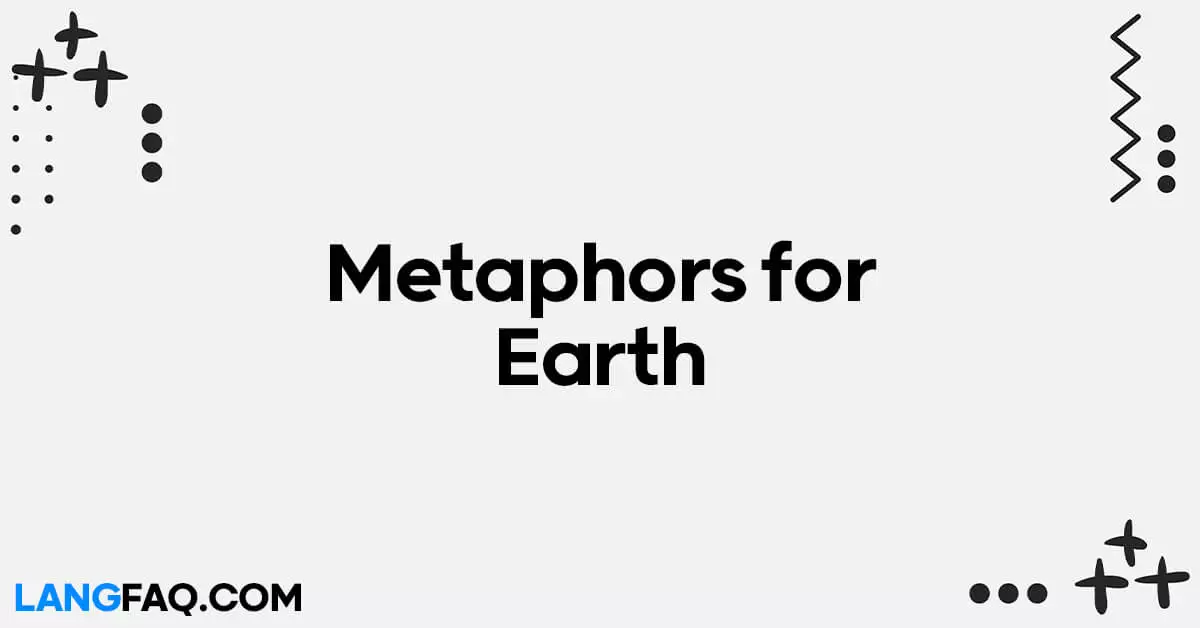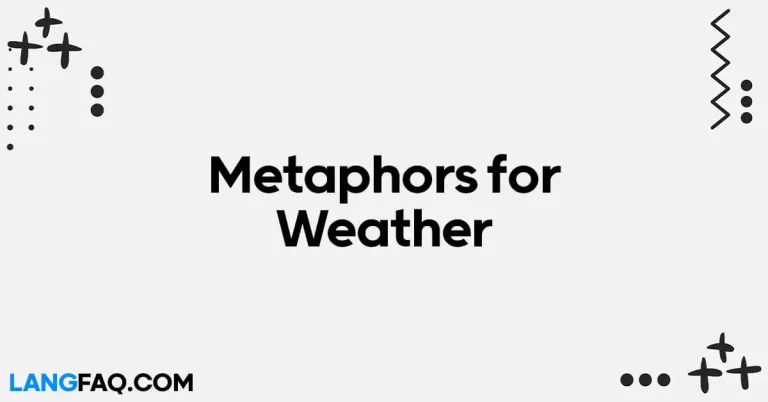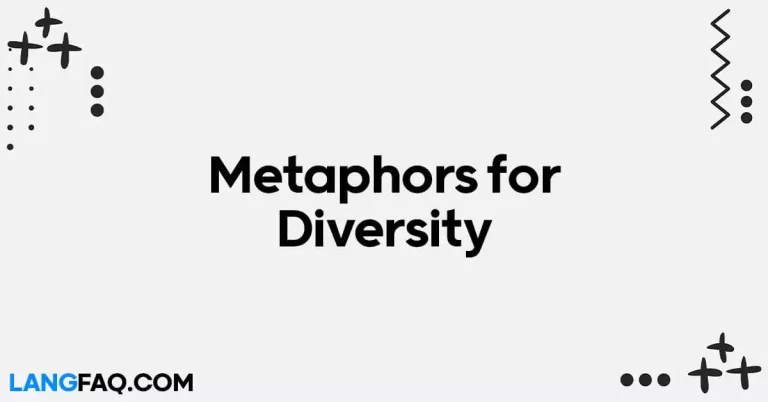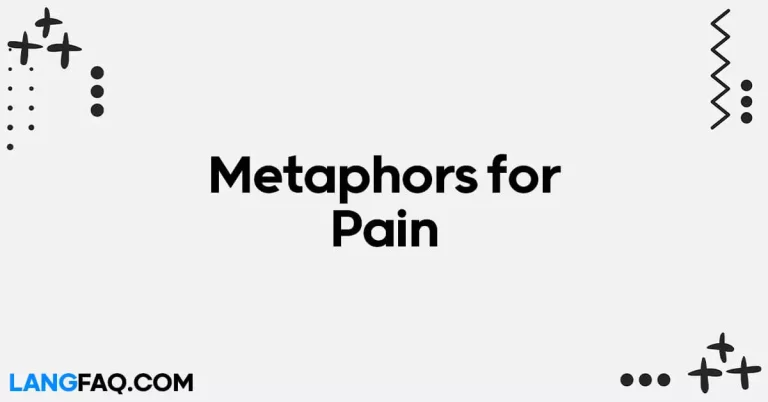Earth, our celestial abode, is often portrayed through metaphors, poetic expressions that capture its essence in imaginative ways. In this exploration, we will delve into 26 captivating metaphors for Earth, each shedding light on the beauty and significance of our home in the vast cosmos.
26 Metaphors for Earth
- The Blue Jewel: Earth, with its vast oceans, is akin to a precious blue jewel in the cosmic necklace of the universe.
- The Garden of Life: Our planet is a thriving garden where the diverse flora and fauna bloom and coexist in a delicate balance.
- The Cosmic Symphony: Earth’s ecosystems harmonize like musical notes, creating a cosmic symphony of interconnected life.
- The Living Canvas: From towering mountains to sprawling plains, Earth is a living canvas painted with the hues of nature.
- The Global Heartbeat: Just as a heartbeat sustains life, Earth’s pulse connects all living beings in a global rhythm.
- The Time Capsule: With layers of history embedded in its rocks, Earth serves as a time capsule preserving the story of our planet.
- The Fragile Orb: Like a delicate orb in space, Earth reminds us of its vulnerability and the need for careful stewardship.
- The Universal Classroom: Nature’s processes become lessons in the universal classroom, teaching us about adaptation and resilience.
- The Sanctuary of Water: Earth is a blue oasis, a sanctuary of water that nurtures and sustains life.
- The Blanket of Life: The atmosphere acts as a protective blanket, regulating temperature and supporting the diverse tapestry of life.
- The Beacon of Hope: Earth stands as a beacon of hope, inspiring collective efforts for a sustainable and brighter future.
- The Interstellar Jewel: Positioned among the stars, Earth shines as an interstellar jewel, unique in its cosmic neighborhood.
- The Global Heritage Site: Natural wonders, like cultural heritage, make Earth a global site worth preserving for future generations.
- The Mirror of Actions: Our actions reflect on Earth like a mirror, influencing the health of the planet and its ecosystems.
- The Playground of Nature: Earth serves as a playground for the joy of recreation, connecting us to the natural world.
- The Symphony of Biodiversity: With diverse life forms, Earth’s biodiversity creates a symphony, each species playing a unique role.
- The Puzzle of Ecosystems: Earth’s interconnected systems form a complex puzzle, highlighting the intricate balance of ecosystems.
- The Living Organism: Viewing Earth as a living organism underscores the interconnectedness of all living beings.
- The Provider of Resources: Earth generously provides resources, emphasizing the importance of sustainable practices.
- The Celestial Heritage: Earth’s celestial position makes it a heritage site in the vast expanse of the cosmos.
- The Classroom of Adaptation: The planet becomes a classroom where organisms learn to adapt, ensuring the survival of species.
- The Medicine Cabinet of Nature: Earth’s biodiversity acts as a medicine cabinet, offering remedies and cures for various ailments.
- The Cosmic Puzzle Piece: Earth fits into the cosmic puzzle, playing a crucial role in the grand tapestry of the universe.
- The Global Mirror: Earth reflects the global impact of human activities, urging responsible choices for a sustainable future.
- The Blank Canvas of Exploration: With unexplored depths and heights, Earth is a blank canvas inviting exploration and discovery.
- The Global Community Home: Earth, our shared abode, unites us as a global community, emphasizing collective responsibility for its well-being.
| Metaphor | Meaning | Examples |
|---|---|---|
| The Blue Jewel | Earth is a precious and unique gem in the vast cosmos. | The glistening oceans give our planet the appearance of a breathtaking blue jewel when seen from space. |
| The Garden of Life | Earth is a flourishing garden with diverse life forms. | The lush rainforests, teeming with flora and fauna, depict Earth as a vibrant and thriving garden of life. |
| The Cosmic Symphony | Earth’s ecosystems create a harmonious cosmic symphony. | The interconnected relationships between species form a celestial symphony, each playing its unique role in the grand composition of nature. |
| The Living Canvas | Earth is a canvas painted with diverse natural landscapes. | From the majestic mountains to the serene meadows, Earth’s varied terrains contribute to the living canvas of our planet. |
| The Global Heartbeat | Earth’s pulse connects all living beings in a rhythmic flow. | The heartbeat metaphor symbolizes the interconnectedness of life on Earth, where every living organism plays a vital role in the planet’s pulse. |
| The Time Capsule | Earth holds layers of history, like a time-keeping capsule. | Rocks and geological formations carry the imprint of Earth’s history, acting as a time capsule that preserves the story of our planet. |
| The Fragile Orb | Earth is delicate and vulnerable, requiring careful care. | The metaphor of Earth as a fragile orb underscores the need for responsible stewardship to protect the delicate balance of our environment. |
| The Universal Classroom | Nature’s processes teach valuable lessons in adaptation. | Earth serves as a universal classroom, offering lessons on adaptation, resilience, and coexistence through the dynamic processes of the natural world. |
| The Sanctuary of Water | Earth is a blue oasis, a source of life-sustaining water. | Oceans, rivers, and lakes form Earth’s blue oasis, providing essential water that supports and nurtures diverse forms of life. |
| The Blanket of Life | Earth’s atmosphere regulates temperature like a protective blanket. | The atmosphere acts as a protective layer, ensuring suitable conditions for life to thrive and creating a metaphorical blanket around the planet. |
| The Beacon of Hope | Earth inspires collective efforts for a brighter future. | As a beacon of hope, Earth encourages humanity to work together, fostering optimism and determination to create a sustainable and positive future. |
| The Interstellar Jewel | Earth shines uniquely among the stars in the vast cosmos. | Positioned in the cosmic expanse, Earth stands out as an interstellar jewel, radiating its brilliance amidst the countless stars of the universe. |
| The Global Heritage Site | Earth’s natural wonders are cultural heritage worth preserving. | The Grand Canyon, the Great Barrier Reef, and other marvels make Earth a global heritage site, deserving protection and conservation for future generations. |
| The Mirror of Actions | Human actions reflect on Earth, influencing its well-being. | Earth as a mirror metaphorically captures the impact of human choices on the environment, emphasizing the need for responsible and sustainable actions. |
| The Playground of Nature | Earth serves as a joyful playground for recreation in nature. | From hiking in lush forests to swimming in pristine lakes, the natural world offers endless opportunities for recreation and joy on Earth’s playground. |
| The Symphony of Biodiversity | Earth’s diverse life forms create a harmonious symphony. | Biodiversity, with its multitude of species, contributes to a symphony of life, each organism playing a unique role in maintaining the balance of ecosystems. |
| The Puzzle of Ecosystems | Earth’s interconnected systems form a complex puzzle. | Ecosystems, with their intricate relationships, represent a puzzle where each species and component plays a crucial role in maintaining ecological balance. |
| The Living Organism | Earth is a living entity with interconnected life forms. | Viewing Earth as a living organism highlights the interdependence of all living beings, emphasizing the importance of preserving the planet’s delicate balance. |
| The Provider of Resources | Earth generously provides essential resources for life. | From freshwater to fertile soil, Earth acts as a provider, furnishing resources that support the survival and well-being of its inhabitants. |
| The Celestial Heritage | Earth’s celestial position makes it a heritage site. | Earth’s position in the solar system, with its unique features and conditions, makes it a celestial heritage worth studying and preserving for scientific exploration. |
| The Classroom of Adaptation | Earth teaches valuable lessons on adaptation. | The natural world, with its ever-changing conditions, serves as a classroom where organisms learn to adapt to survive and thrive in their environments. |
| The Medicine Cabinet of Nature | Earth’s biodiversity offers remedies and cures. | Earth’s diverse flora and fauna provide medicinal resources, acting as a medicine cabinet with the potential for discovering new treatments and cures for various ailments. |
| The Cosmic Puzzle Piece | Earth fits into the cosmic puzzle of the universe. | In the vastness of the cosmos, Earth plays a vital role as a puzzle piece, contributing to the intricate and interconnected tapestry of the universe. |
| The Global Mirror | Human actions reflect globally, impacting Earth’s health. | Earth as a global mirror symbolizes how the consequences of human activities are reflected worldwide, emphasizing the need for responsible and sustainable choices. |
| The Blank Canvas of Exploration | Earth invites exploration and discovery. | With unexplored territories and mysteries, Earth is a blank canvas awaiting exploration, encouraging curiosity and the quest for new discoveries. |
| The Global Community Home | Earth unites us as a global community, our shared home. | The metaphor of Earth as a global community home emphasizes the interconnectedness of humanity and the shared responsibility for the well-being of our planet. |
These metaphors for Earth offer a rich tapestry of perspectives, illuminating the planet’s significance and beauty. From the delicate fragility of an orb to the inspiring beacon of hope, each metaphor underscores the interconnectedness of life on our shared home. Earth, a living canvas, a global classroom, and a sanctuary of water, invites us to appreciate, protect, and sustain the delicate balance that makes our planet a celestial jewel in the vast cosmic symphony. These metaphors serve as poignant reminders of our collective responsibility to preserve Earth’s heritage, biodiversity, and the interconnected web of life for future generations.
The Blue Jewel: Earth’s Celestial Elegance
Earth, often hailed as the Blue Jewel of the cosmos, embodies a celestial elegance that captivates observers from the depths of space. This metaphor highlights the planet’s unique and precious nature, emphasizing its significance in the vast tapestry of the universe.
Definition and Context:
In both formal and informal contexts, the Blue Jewel metaphor can be employed to evoke a sense of admiration and awe for Earth’s beauty. It is suitable for professional discussions, casual conversations, and even creative expressions.
Example Sentence:
Formal Context (Colleagues): “As we analyze the images of Earth taken from the satellite, it’s impossible not to marvel at the celestial elegance of our Blue Jewel amidst the cosmic expanse.”
Informal Context (Friends): “Have you seen those space documentaries lately? Earth truly is the Blue Jewel, shining bright in the dark sea of space!”
Grammar and Usage Tips:
- Capitalize “Blue Jewel” when used as a proper noun to refer specifically to Earth.
- Use it as a metaphorical expression, emphasizing Earth’s unique and striking appearance.
Pros and Cons:
Pros:
- Evokes a sense of wonder and admiration.
- Appeals to emotions, making discussions more engaging.
Cons:
- May be considered overly poetic in extremely formal settings.
Related Insights: Cambridge Dictionary defines a jewel as a precious stone that is used to decorate valuable objects. The Blue Jewel metaphor draws on the idea of Earth as a precious, invaluable entity in the cosmic context.
The Garden of Life: Earth’s Flourishing Biodiversity
Imagine Earth as a vibrant Garden of Life, where the rich tapestry of ecosystems blooms with diverse flora and fauna, creating a harmonious and interconnected environment.
Definition and Context:
The Garden of Life metaphor is versatile, suitable for conveying the idea of Earth as a thriving habitat for various life forms. It can be used in scientific discussions, casual dialogues, or even in environmental advocacy.
Example Sentence:
Formal Context (Scientific Presentation): “In exploring the Amazon rainforest, scientists witness firsthand the incredible biodiversity that makes Earth a true Garden of Life.”
Informal Context (Casual Conversation): “I was watching this documentary, and they described Earth as a Garden of Life – how cool is that? So many different plants and animals coexisting!”
Grammar and Usage Tips:
- Capitalize “Garden of Life” when used as a proper noun to refer specifically to Earth’s biodiversity.
- Utilize it to emphasize the interconnectedness and coexistence of various life forms.
Pros and Cons:
Pros:
- Conveys the idea of Earth as a flourishing, vibrant ecosystem.
- Resonates well with environmental discussions.
Cons:
- May be perceived as metaphorical and less scientific in highly technical contexts.
Related Insights: The metaphor aligns with the concept of Earth as a biosphere, an ecosystem where living organisms interact with one another and their environment. It reinforces the idea that Earth is not just a planet but a living, breathing entity.
The Cosmic Symphony: Nature’s Harmonious Melody
Earth’s ecosystems, like musical notes in a Cosmic Symphony, create a harmonious melody that resonates throughout the universe.
Definition and Context:
The Cosmic Symphony metaphor is ideal for describing the interconnectedness of Earth’s ecosystems and their balanced coexistence. It suits both scientific discussions and creative expressions.
Example Sentence:
Formal Context (Ecological Research Paper): “Analyzing the intricate relationships between species, we can discern the natural patterns that contribute to Earth’s Cosmic Symphony of life.”
Informal Context (Creative Writing): “I often think of nature as this incredible orchestra – the wind, the trees, the animals – all playing together in a Cosmic Symphony that never ceases to amaze.”
Grammar and Usage Tips:
- Capitalize “Cosmic Symphony” when used as a proper noun to denote the interconnectedness of Earth’s ecosystems.
- Employ it to emphasize the balance and harmony in nature.
Pros and Cons:
Pros:
- Creates a vivid and poetic image of Earth’s ecosystems.
- Enhances discussions about ecological balance.
Cons:
- Might be considered too artistic in strictly scientific settings.
Related Insights: The metaphor draws on the notion that ecosystems, like musical notes, contribute to a larger composition. It aligns with the ecological perspective that emphasizes the interdependence of species and the delicate balance of nature.
The Living Canvas: Earth’s Diverse Artistry
As we delve into Earth as a Living Canvas, we uncover a palette of diverse landscapes and breathtaking scenery that paints a vivid portrait of our planet’s natural beauty.
Definition and Context:
The Living Canvas metaphor encapsulates the idea of Earth as a dynamic masterpiece, showcasing various terrains and ecosystems. It seamlessly fits into both artistic descriptions and discussions about Earth’s geographical diversity.
Example Sentence:
Formal Context (Geographical Presentation): “In examining satellite imagery, we witness the Living Canvas that Earth presents, featuring deserts, mountains, and oceans as unique strokes of nature’s artistic expression.”
Informal Context (Casual Observation): “Isn’t it amazing how our planet is like this Living Canvas? I mean, you have the snowy mountains, the lush forests – it’s like nature is the greatest artist ever!”
Grammar and Usage Tips:
- Capitalize “Living Canvas” when emphasizing Earth’s diverse landscapes.
- Utilize it to evoke images of Earth’s natural artistry and geographical variety.
Pros and Cons:
Pros:
- Provides a visual and imaginative representation of Earth’s diverse landscapes.
- Enhances discussions about geography and nature’s aesthetics.
Cons:
- May be perceived as metaphorical and less scientific in highly technical contexts.
Related Insights: The Living Canvas metaphor draws on the concept that Earth’s landscapes are not static but ever-changing, influenced by geological processes, climate, and human activities.
The Global Heartbeat: Earth’s Rhythmic Unity
In envisioning Earth’s Global Heartbeat, we grasp the interconnected pulse that unites all living beings, fostering a sense of rhythm and unity across the planet.
Definition and Context:
The Global Heartbeat metaphor encapsulates the idea of Earth as a living entity with a rhythmic pulse that resonates through ecosystems. It is suitable for discussions ranging from environmental studies to philosophical reflections.
Example Sentence:
Formal Context (Environmental Symposium): “In exploring the impact of climate change, understanding Earth’s Global Heartbeat becomes crucial, as shifts in this rhythmic unity affect the well-being of diverse ecosystems.”
Informal Context (Philosophical Conversation): “It’s like we’re all part of this enormous symphony – Earth’s Global Heartbeat. Each species, each ecosystem, contributing to this grand, interconnected melody of life.”
Grammar and Usage Tips:
- Capitalize “Global Heartbeat” when emphasizing the interconnected pulse of Earth’s ecosystems.
- Use it to evoke a sense of unity and shared existence among diverse species.
Pros and Cons:
Pros:
- Symbolizes the interdependence of life on Earth.
- Invokes a sense of shared responsibility for environmental well-being.
Cons:
- Might be considered too metaphorical in strictly scientific discussions.
Related Insights: The Global Heartbeat metaphor aligns with the ecological perspective that emphasizes the interconnection and interdependence of different ecosystems, creating a harmonious rhythm across the planet.
The Time Capsule: Earth’s Historical Repository
Earth, as a Time Capsule, holds within its geological layers the rich history of our planet, preserving a chronicle of the past for present and future generations.
Definition and Context:
The Time Capsule metaphor conveys the idea of Earth as a repository of historical information, particularly within its geological formations. It is suitable for discussions on geology, paleontology, and environmental history.
Example Sentence:
Formal Context (Geological Research): “Studying sedimentary layers provides us with a glimpse into Earth’s Time Capsule, unraveling the environmental changes and evolutionary processes that have shaped our world.”
Informal Context (Educational Discussion): “Have you ever thought of Earth as a Time Capsule? Fossils, rock formations – they’re like pages in a book, telling the story of our planet’s incredible journey.”
Grammar and Usage Tips:
- Capitalize “Time Capsule” when emphasizing Earth’s historical repository.
- Utilize it to underscore the idea that Earth’s geological layers hold valuable information about its past.
Pros and Cons:
Pros:
- Highlights Earth’s role as a recorder of environmental history.
- Adds a layer of historical significance to geological discussions.
Cons:
- May be perceived as less scientific and more metaphorical in certain contexts.
Related Insights: The Time Capsule metaphor aligns with the geological perspective that Earth’s layers contain information about past climates, extinctions, and evolutionary events, providing invaluable insights into the planet’s history.
The Blanket of Life: Earth’s Protective Shield
Picture Earth as a Blanket of Life, where the atmosphere serves as a protective shield, regulating temperature and fostering the conditions essential for the diverse tapestry of life.
Definition and Context:
The Blanket of Life metaphor emphasizes the crucial role of Earth’s atmosphere in sustaining life. It seamlessly fits into discussions about climate, environmental science, and the delicate balance necessary for the planet’s ecosystems.
Example Sentence:
Formal Context (Climate Research Conference): “As we analyze the intricate dynamics of Earth’s Blanket of Life, it becomes evident that understanding atmospheric processes is paramount for comprehending climate change and its impacts.”
Informal Context (Casual Explanation): “Think of the atmosphere as Earth’s Blanket of Life. It keeps us warm, shields us from the extremes – it’s like our planet’s cozy protective layer.”
Grammar and Usage Tips:
- Capitalize “Blanket of Life” when emphasizing the protective nature of Earth’s atmosphere.
- Utilize it to convey the importance of the atmosphere in maintaining a habitable environment.
Pros and Cons:
Pros:
- Provides a tangible metaphor for understanding the role of the atmosphere.
- Enhances discussions about climate and environmental protection.
Cons:
- May be perceived as less scientific in highly technical contexts.
Related Insights: The metaphor draws on the idea that the atmosphere, like a blanket, helps regulate temperature by trapping heat and creating conditions conducive to life.
The Beacon of Hope: Earth’s Inspirational Light
Consider Earth as a Beacon of Hope, radiating inspiration and resilience as it navigates challenges, encouraging collective efforts for a brighter and sustainable future.
Definition and Context:
The Beacon of Hope metaphor symbolizes Earth as a source of inspiration, urging humanity to come together for positive change. It suits discussions about sustainability, environmental activism, and the human impact on the planet.
Example Sentence:
Formal Context (Environmental Advocacy Symposium): “As we delve into strategies for environmental conservation, let us view Earth as a Beacon of Hope, a guiding light that inspires us to safeguard our shared home.”
Informal Context (Motivational Conversation): “It’s easy to feel overwhelmed, but Earth is like this Beacon of Hope. Every positive action, no matter how small, adds to the collective effort for a better future.”
Grammar and Usage Tips:
- Capitalize “Beacon of Hope” when emphasizing Earth’s inspirational role.
- Use it to evoke a sense of optimism and motivation for positive change.
Pros and Cons:
Pros:
- Encourages a positive perspective on environmental challenges.
- Inspires collective action for a sustainable future.
Cons:
- Might be perceived as less scientific in strictly technical contexts.
Related Insights: The Beacon of Hope metaphor aligns with the idea that Earth’s resilience and ability to recover from challenges can serve as an inspiration for individuals and communities working towards positive environmental change.
The Playground of Nature: Earth’s Joyful Recreation Hub
Imagine Earth as a vast Playground of Nature, where the wonders of the natural world invite us to explore, connect, and find joy in the diverse recreational opportunities it offers.
Definition and Context:
The Playground of Nature metaphor paints Earth as a space for leisure, adventure, and enjoyment in the great outdoors. It’s a versatile expression fitting for discussions on ecotourism, outdoor activities, and the positive impact of nature on well-being.
Example Sentence:
Formal Context (Ecotourism Presentation): “As we promote sustainable tourism, recognizing Earth as a Playground of Nature emphasizes the importance of preserving natural habitats for responsible recreation and enjoyment.”
Informal Context (Enthusiastic Chat): “Nature is like the best playground ever, right? Mountains to climb, rivers to kayak – Earth truly is the ultimate Playground of Nature!”
Grammar and Usage Tips:
- Capitalize “Playground of Nature” to emphasize Earth’s recreational potential.
- Utilize it to highlight the positive aspects of outdoor activities and their impact on well-being.
Pros and Cons:
Pros:
- Encourages a positive view of nature as a source of joy and recreation.
- Fits well into discussions about sustainable tourism and outdoor activities.
Cons:
- May be perceived as less formal in strictly academic or scientific contexts.
Related Insights: The Playground of Nature metaphor aligns with the idea that Earth’s natural landscapes offer opportunities for rejuvenation, adventure, and connection with the environment.
The Symphony of Biodiversity: Nature’s Harmonious Orchestra
Envision Earth as a Symphony of Biodiversity, where the diverse life forms contribute to a harmonious orchestra, each species playing a unique role in the grand composition of the planet.
Definition and Context:
The Symphony of Biodiversity metaphor captures the intricate relationships between Earth’s diverse species, emphasizing the interconnected web of life. It suits discussions on conservation, ecology, and the importance of preserving biodiversity.
Example Sentence:
Formal Context (Conservation Symposium): “Exploring strategies for biodiversity conservation, we must recognize Earth as a Symphony of Biodiversity, where each species plays a crucial note in maintaining the balance of ecosystems.”
Informal Context (Casual Nature Conversation): “I was reading about biodiversity, you know, the Symphony of Biodiversity. It’s like every living thing has a role, just like instruments in an orchestra.”
Grammar and Usage Tips:
- Capitalize “Symphony of Biodiversity” to emphasize Earth’s intricate ecological composition.
- Utilize it to convey the idea of balance and interconnectedness in ecosystems.
Pros and Cons:
Pros:
- Evokes a powerful image of Earth’s ecological harmony.
- Reinforces the importance of biodiversity conservation.
Cons:
- May be considered metaphorical in extremely technical scientific contexts.
Related Insights: The Symphony of Biodiversity metaphor aligns with the ecological perspective that views ecosystems as complex compositions where each species contributes to the overall balance and function.
The Puzzle of Ecosystems: Earth’s Interconnected Enigma
View Earth as a Puzzle of Ecosystems, where interconnected systems form a complex enigma, highlighting the intricate balance that sustains life on the planet.
Definition and Context:
The Puzzle of Ecosystems metaphor emphasizes the interconnectedness and delicate balance of Earth’s diverse ecosystems. It’s fitting for discussions on ecology, environmental science, and the impact of human activities on natural systems.
Example Sentence:
Formal Context (Environmental Impact Assessment): “In assessing the effects of urban development, recognizing Earth as a Puzzle of Ecosystems underscores the importance of maintaining biodiversity and ecological balance.”
Informal Context (Educational Conversation): “Ever thought about ecosystems like a puzzle? It’s fascinating how each piece fits, and when we disturb it, the whole picture changes. Earth is like this giant Puzzle of Ecosystems.”
Grammar and Usage Tips:
- Capitalize “Puzzle of Ecosystems” to emphasize the complexity and interconnected nature of Earth’s ecosystems.
- Utilize it to convey the idea that ecosystems are interdependent and form a larger ecological puzzle.
Pros and Cons:
Pros:
- Highlights the importance of ecological balance.
- Provides a metaphor for understanding the interconnectedness of ecosystems.
Cons:
- May be considered less scientific in extremely technical contexts.
Related Insights: The Puzzle of Ecosystems metaphor aligns with the ecological concept that disruptions in one part of an ecosystem can have cascading effects, impacting the entire system’s balance.
The Living Organism: Earth’s Interconnected Life Forms
Contemplate Earth as a Living Organism, where every species, from the smallest microorganism to the largest mammals, contributes to the intricate web of life, highlighting the planet’s delicate balance.
Definition and Context:
The Living Organism metaphor signifies Earth’s interconnected life forms, emphasizing the interdependence and mutual influence of diverse species. It’s applicable to discussions on ecology, biodiversity, and the need for sustainable practices.
Example Sentence:
Formal Context (Biodiversity Conference): “In the quest for biodiversity conservation, recognizing Earth as a Living Organism underscores the need to protect the varied species that collectively form the intricate tapestry of life.”
Informal Context (Nature Enthusiast Chat): “Isn’t it fascinating how Earth is like this giant living thing? Every creature, every plant – we’re all part of this incredible Living Organism.”
Grammar and Usage Tips:
- Capitalize “Living Organism” to emphasize Earth’s interconnected web of life.
- Utilize it to convey the idea that all living beings play a vital role in the health of the planet.
Pros and Cons:
Pros:
- Enhances understanding of Earth’s interconnected ecosystems.
- Emphasizes the importance of protecting biodiversity.
Cons:
- May be considered metaphorical in extremely technical scientific discussions.
Related Insights: The Living Organism metaphor aligns with the ecological perspective that views Earth as a system where every living organism, regardless of size, contributes to the overall health and functioning of the planet.
The Provider of Resources: Earth’s Generosity
Consider Earth as the Provider of Resources, a nurturing entity that generously supplies essential elements such as freshwater, fertile soil, and various raw materials to sustain and support life.
Definition and Context:
The Provider of Resources metaphor highlights Earth’s role in furnishing the necessities for life, making it suitable for discussions on sustainability, resource management, and environmental stewardship.
Example Sentence:
Formal Context (Sustainable Development Seminar): “As we explore sustainable practices, acknowledging Earth as the Provider of Resources emphasizes the importance of responsible resource management for current and future generations.”
Informal Context (Everyday Conversation): “Have you ever thought about how Earth is like this giant provider? Water, food, materials – it’s like the ultimate Provider of Resources!”
Grammar and Usage Tips:
- Capitalize “Provider of Resources” to underscore Earth’s role in supplying essential elements.
- Utilize it to convey the idea that Earth’s resources should be used responsibly and sustainably.
Pros and Cons:
Pros:
- Highlights the generosity of Earth in providing essential resources.
- Reinforces the importance of sustainable resource management.
Cons:
- May be perceived as less formal in strictly academic or scientific contexts.
Related Insights: The Provider of Resources metaphor aligns with the concept of Earth as a source of life-sustaining elements, emphasizing the need for responsible utilization and conservation of these resources.
The Celestial Heritage: Earth’s Cosmic Significance
Envision Earth as a Celestial Heritage, a unique and significant entity in the cosmos, with its celestial position, features, and conditions making it worthy of study and preservation.
Definition and Context:
The Celestial Heritage metaphor emphasizes Earth’s cosmic importance, making it suitable for discussions on astronomy, planetary science, and the broader context of Earth within the universe.
Example Sentence:
Formal Context (Planetary Exploration Symposium): “As we delve into celestial studies, acknowledging Earth as a Celestial Heritage prompts us to appreciate and preserve the unique features that make our planet a focal point of scientific exploration.”
Informal Context (Cosmic Wonder Chat): “Isn’t Earth like this special heritage in the cosmos? Our position, our conditions – it’s like we’re the Celestial Heritage of the universe!”
Grammar and Usage Tips:
- Capitalize “Celestial Heritage” to underscore Earth’s unique significance in the cosmos.
- Utilize it to convey the idea that Earth’s celestial features make it noteworthy in scientific exploration.
Pros and Cons:
Pros:
- Highlights Earth’s cosmic importance and unique features.
- Encourages appreciation for scientific exploration.
Cons:
- May be considered metaphorical in highly technical astronomical discussions.
Related Insights: The Celestial Heritage metaphor aligns with the idea that Earth, with its specific conditions and position in the solar system, offers valuable insights for understanding planetary processes and the potential for life beyond our planet.
The Classroom of Adaptation: Earth’s Evolutionary Lessons
Visualize Earth as the Classroom of Adaptation, a dynamic learning space where life forms evolve and adapt to the ever-changing conditions, showcasing the resilience and ingenuity of the planet’s diverse ecosystems.
Definition and Context:
The Classroom of Adaptation metaphor highlights Earth’s role as an environment where organisms undergo evolutionary processes, adapting to challenges and changes. It suits discussions on evolution, biology, and the interconnectedness of species.
Example Sentence:
Formal Context (Evolutionary Biology Seminar): “Exploring the intricacies of adaptation, we must recognize Earth as the Classroom of Adaptation, where species evolve in response to environmental shifts, showcasing the resilience embedded in our planet’s biology.”
Informal Context (Nature Documentary Watching): “Nature is like this amazing classroom, you know? Creatures adapting, evolving – Earth truly is the Classroom of Adaptation!”
Grammar and Usage Tips:
- Capitalize “Classroom of Adaptation” to emphasize Earth’s role as a dynamic learning space.
- Utilize it to convey the idea that Earth provides valuable lessons in adaptation and evolution.
Pros and Cons:
Pros:
- Enhances understanding of Earth’s role in evolutionary processes.
- Highlights the resilience and adaptability of life on the planet.
Cons:
- May be perceived as less formal in strictly academic or scientific contexts.
Related Insights: The Classroom of Adaptation metaphor aligns with the biological perspective that views Earth’s ecosystems as dynamic environments where species evolve to survive and thrive in changing conditions.
The Medicine Cabinet of Nature: Earth’s Natural Remedies
Think of Earth as the Medicine Cabinet of Nature, a vast repository of natural remedies, where plants, minerals, and ecosystems offer healing properties that have been utilized by various cultures for centuries.
Definition and Context:
The Medicine Cabinet of Nature metaphor emphasizes Earth’s abundance of medicinal resources, making it suitable for discussions on herbalism, ethnobotany, and the importance of biodiversity in traditional medicine.
Example Sentence:
Formal Context (Ethnobotanical Research Presentation): “In exploring traditional healing practices, understanding Earth as the Medicine Cabinet of Nature sheds light on the rich biodiversity that has provided remedies for human ailments across diverse cultures.”
Informal Context (Health-conscious Conversation): “Have you ever considered nature as our giant Medicine Cabinet? Herbs, plants – Earth is like this amazing source of natural remedies!”
Grammar and Usage Tips:
- Capitalize “Medicine Cabinet of Nature” to emphasize Earth’s role as a source of natural remedies.
- Utilize it to convey the idea that Earth’s biodiversity contributes to the field of natural medicine.
Pros and Cons:
Pros:
- Highlights the importance of biodiversity in traditional medicine.
- Encourages appreciation for nature’s healing properties.
Cons:
- May be perceived as less formal in strictly medical or scientific contexts.
Related Insights: The Medicine Cabinet of Nature metaphor aligns with the idea that Earth’s ecosystems provide a wealth of medicinal resources, contributing to the development of traditional healing practices.
The Cosmic Clockwork: Earth’s Timekeeping Mechanism
Consider Earth as the Cosmic Clockwork, a celestial timekeeping mechanism where natural processes, seasons, and geological events operate in a harmonious rhythm, marking the passage of time on our planet.
Definition and Context:
The Cosmic Clockwork metaphor emphasizes Earth’s natural cycles and the rhythmic precision with which events unfold over time. It’s suitable for discussions on geology, climate science, and the interconnected nature of Earth’s processes.
Example Sentence:
Formal Context (Geological Time Scale Symposium): “In examining Earth’s geological history, recognizing our planet as the Cosmic Clockwork underscores the intricate timing of geological events that shape the landscapes we see today.”
Informal Context (Stargazing Conversation): “Have you ever thought about Earth as this giant clock? Seasons changing, tides flowing – it’s like we’re part of this amazing Cosmic Clockwork!”
Grammar and Usage Tips:
- Capitalize “Cosmic Clockwork” to emphasize Earth’s role as a celestial timekeeper.
- Utilize it to convey the idea that natural processes on Earth operate with rhythmic precision.
Pros and Cons:
Pros:
- Enhances understanding of Earth’s natural cycles and timing.
- Invokes a sense of awe and interconnectedness with cosmic processes.
Cons:
- May be considered metaphorical in strictly technical geological discussions.
Related Insights: The Cosmic Clockwork metaphor aligns with the idea that Earth’s geological and climatic processes function in a rhythmic manner, contributing to the planet’s dynamic and ever-changing nature.
The Guardian of Climate: Earth’s Stewardship Role
Envision Earth as the Guardian of Climate, a responsible steward that maintains the delicate balance of atmospheric conditions, ensuring the sustainability of ecosystems and the well-being of all living beings.
Definition and Context:
The Guardian of Climate metaphor emphasizes Earth’s crucial role in regulating climate and fostering conditions conducive to life. It’s fitting for discussions on climate science, environmental stewardship, and the impact of human activities on the planet.
Example Sentence:
Formal Context (Climate Stewardship Symposium): “As we navigate the complexities of climate change, acknowledging Earth as the Guardian of Climate emphasizes the responsibility we share in preserving the delicate balance that sustains our planet’s diverse ecosystems.”
Informal Context (Environmental Advocacy Chat): “Earth is like our climate’s guardian, right? It keeps everything in check, and we need to do our part to help maintain that balance.”
Grammar and Usage Tips:
- Capitalize “Guardian of Climate” to underscore Earth’s stewardship role in climate regulation.
- Utilize it to convey the idea that Earth plays a vital role in sustaining the global climate.
Pros and Cons:
Pros:
- Reinforces the importance of environmental stewardship.
- Invokes a sense of shared responsibility for climate preservation.
Cons:
- May be perceived as less formal in strictly scientific or policy-related contexts.
Related Insights: The Guardian of Climate metaphor aligns with the environmental perspective that views Earth as a guardian responsible for maintaining a climate conducive to the survival and flourishing of diverse ecosystems.
The Blueprint of Sustainability: Earth’s Model for Balance
Consider Earth as the Blueprint of Sustainability, a model that illustrates the harmonious balance between natural processes, ecosystems, and human activities, inspiring sustainable practices for the well-being of the planet.
Definition and Context:
The Blueprint of Sustainability metaphor emphasizes Earth’s inherent balance and serves as a guide for sustainable living. It’s suitable for discussions on environmental conservation, green practices, and the pursuit of a balanced and resilient planet.
Example Sentence:
Formal Context (Sustainable Development Conference): “In our quest for sustainable living, recognizing Earth as the Blueprint of Sustainability provides a roadmap for cultivating a balance between human activities and the preservation of the planet’s natural systems.”
Informal Context (Everyday Green Choices): “Earth is like the ultimate blueprint for how to live sustainably, right? It’s all about finding that balance that keeps everything thriving.”
Grammar and Usage Tips:
- Capitalize “Blueprint of Sustainability” to underscore Earth’s role as a model for sustainable living.
- Utilize it to convey the idea that Earth provides a blueprint for achieving balance and resilience.
Pros and Cons:
Pros:
- Encourages the adoption of sustainable practices.
- Inspires a sense of responsibility for preserving Earth’s balance.
Cons:
- May be perceived as less formal in strictly academic or scientific contexts.
Related Insights: The Blueprint of Sustainability metaphor aligns with the idea that Earth’s natural processes and ecosystems serve as a guide for human activities, emphasizing the need to adopt practices that ensure the long-term health of the planet.
The Masterpiece of Diversity: Earth’s Multifaceted Canvas
Imagine Earth as the Masterpiece of Diversity, a canvas painted with a rich palette of cultures, landscapes, and life forms, showcasing the planet’s extraordinary variety and the interconnectedness of all its elements.
Definition and Context:
The Masterpiece of Diversity metaphor highlights Earth’s cultural, biological, and geographical richness. It suits discussions on biodiversity, cultural diversity, and the interconnectedness of global systems.
Example Sentence:
Formal Context (Biodiversity Conservation Seminar): “In the pursuit of preserving biodiversity, recognizing Earth as the Masterpiece of Diversity underscores the importance of protecting the multitude of species that contribute to the intricate tapestry of life.”
Informal Context (Cultural Appreciation Chat): “Have you ever thought about Earth as this incredible masterpiece of diversity? Different cultures, languages – it’s like we’re living on this vibrant, diverse canvas.”
Grammar and Usage Tips:
- Capitalize “Masterpiece of Diversity” to emphasize Earth’s role as a diverse and interconnected entity.
- Utilize it to convey the idea that Earth’s variety is a testament to its beauty and resilience.
Pros and Cons:
Pros:
- Celebrates the richness of cultural and biological diversity.
- Encourages appreciation for the interconnectedness of global systems.
Cons:
- May be perceived as less formal in strictly academic or scientific contexts.
Related Insights: The Masterpiece of Diversity metaphor aligns with the idea that Earth’s diversity, whether in terms of ecosystems or human cultures, contributes to the planet’s vibrancy and resilience.
Conclusion
In this journey through metaphors, we’ve explored the multifaceted beauty and significance of Earth. From a cosmic jewel to a living organism, each metaphor invites us to appreciate and protect our planet. Let these poetic expressions serve as a reminder of our shared responsibility in preserving the home we all call Earth.
Frequently Asked Questions
Q: Are metaphors for Earth only poetic expressions? A: While metaphors are indeed poetic, they also offer unique perspectives on the planet’s characteristics and significance, enhancing our understanding beyond literal descriptions.
Q: How can Earth be both a classroom and a playground? A: Earth as a classroom represents the lessons we learn from nature, while the playground metaphor emphasizes the joy and recreation found in the natural world, showcasing the balance between education and leisure.
Q: Why is Earth compared to a time capsule? A: Earth, as a time capsule, encapsulates the history of our planet. This metaphor underscores the importance of preserving our heritage for future generations.
Q: How does the Earth act as a provider? A: Earth provides essential resources such as water, air, and biodiversity. Recognizing its role as a provider encourages sustainable practices to ensure the planet’s ability to support life.
Q: Can Earth be both a fragile orb and a beacon of hope? A: Yes, the fragility of Earth emphasizes the need for responsible stewardship, while the beacon of hope metaphor inspires collective efforts to build a resilient and sustainable future.
Q: What is the significance of Earth as a mirror? A: Earth as a mirror reflects the consequences of human actions on the environment. Recognizing this significance prompts positive changes for a healthier reflection of our impact on the planet.







